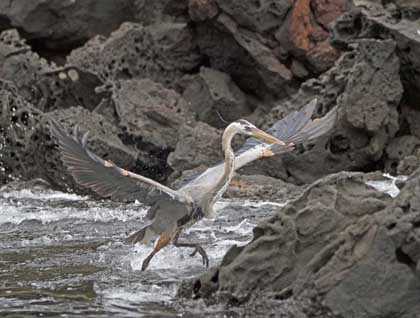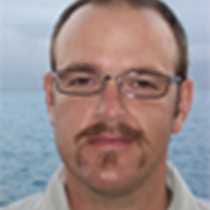A light breeze and grey sky greet us as we awaken at Bartolome Island. In the early morning we land at Bartolome as a few sun beams break through the overcast sky and we proceed to climb hundreds of steps to the top of this desolate island. A few pioneer plant species including lava cacti seem to be holding onto the wind swept ash slopes and spatter cone formations that surround us. The summit gives us a view of the surrounding islands including Santiago Island, and a recent lava flow gives us a look at a black basalt flow that came down from a large shield volcano. A pattern of volcanic formations are seen in almost every direction. After a hearty breakfast and obtaining our snorkeling gear we are off again to Bartolome as we land on its fine sand beach and proceed to snorkel. Galapagos lacks large coral reefs, however an abundance of life greets us with white tipped reef sharks, diamond sting rays, and a plethora of different fish species that are seen by many.
Midday finds us weighing anchor and starting navigation towards the southern part of Santiago and a satellite island named Rabida. A surprising contrast of color is seen as we approach, finding a bright red volcanic island with white Palo Santo incense trees covering most of the area with a thin green line of coastal salt brush. Kayakers take to the coastal area as they paddle among Pacific green sea turtles and the occasional Galapagos sea lion. Steep crimson cliffs show the gradual erosion of this island with brown pelicans and frigate birds cruising along the shore. Snorkelers encounter turtles, parrot fish, and large aggregations of razor surgeon fish. A quick change is needed and eventually we continue our exploration with a landing. As the sun occasionally peaks from the clouds we land to walk along the shoreline and come across numerous sea lions. It appears that the sea lions are exhausted after their foraging runs and we notice a couple of very large and pregnant females that may give birth at any time. Numerous remnants of the undersea world are found washed up, including sea urchin, sea stars, and many different mollusk shells. The end of our day is brightened by the appearance of a vermillion flycatcher with its bright red against the greenery of the coastal vegetation. The flycatcher proceeds to snap up a few insects and in a moment disappears, leaving us with an impression that nature is always on the move.









